Leptogenys truncatirostris
| Leptogenys truncatirostris | |
|---|---|

| |
| Scientific classification | |
| Kingdom: | Animalia |
| Phylum: | Arthropoda |
| Class: | Insecta |
| Order: | Hymenoptera |
| Family: | Formicidae |
| Subfamily: | Ponerinae |
| Tribe: | Ponerini |
| Genus: | Leptogenys |
| Species group: | truncatirostris |
| Species complex: | truncatirostris |
| Species: | L. truncatirostris |
| Binomial name | |
| Leptogenys truncatirostris Forel, 1897 | |
A common species, foraging behavior for this species is carried out mostly on the forest floor and rarely above ground on low vegetation. In the RP Berenty, workers of L. truncatirostris were found carrying larvae and cocoons and exhibiting tandem running during a nest relocation. This species generally nests in rotten logs, rotting bamboo, in soil layers, under rocks and under dead wood.
Identification
A member of the truncatirostris complex of the truncatirostris species group. Rakotonirina and Fisher (2014) - Worker. Clypeus wide and transverse, without projecting anteromedian lobe; median clypeal carina lacking; lateral portion meets the anterior margin of clypeus in a blunt angle. In profile, mandible curved dorsally with midpoint markedly dorsal of mandible insertion; distal half of blade slightly broader and flattened, the surface with effaced fine striation; in profile, third abdominal segment densely and finely punctate, dorsum of mesosoma, petiolar node, and gaster with numerous pubescences.
Leptogenys truncatirostris is very similar to Leptogenys diana but the latter can be distinguished by the broadly rounded anterior clypeal margin, the absence of pubescence on the dorsum of the body, and the presence of microreticulation with sparse punctures on the third abdominal tergite. Also, the basal third of the mandible is more robust and the distal half is broader and finely striate
Keys including this Species
Distribution
As one of the most common species within the truncatirostris group, L. truncatirostris is widespread in western Madagascar, occurring from dry forest on Tsingy, gallery forest, littoral forests in the north to south-west as well as spiny bush and thicket habitats in the extreme south of the island. This species also can be discovered in anthropogenic habitats such as disturbed forests and roadsides. (Rakotonirina and Fisher 2014)
Distribution based on Regional Taxon Lists
Malagasy Region: Madagascar (type locality), Mayotte.
Distribution based on AntMaps
Distribution based on AntWeb specimens
Check data from AntWeb
Countries Occupied
| Number of countries occupied by this species based on AntWiki Regional Taxon Lists. In general, fewer countries occupied indicates a narrower range, while more countries indicates a more widespread species. |

|
Estimated Abundance
| Relative abundance based on number of AntMaps records per species (this species within the purple bar). Fewer records (to the left) indicates a less abundant/encountered species while more records (to the right) indicates more abundant/encountered species. |

|
Biology
|
Castes
Images from AntWeb
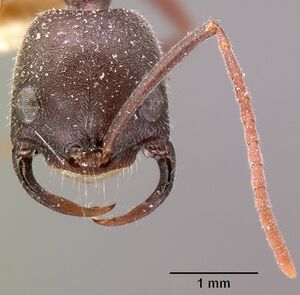
| |
| Worker. Specimen code casent0101133. Photographer April Nobile, uploaded by California Academy of Sciences. | Owned by NHMB, Basel, Switzerland. |
   
| |
| Paralectotype of Leptogenys truncatirostris. Worker. Specimen code casent0101626. Photographer April Nobile, uploaded by California Academy of Sciences. | Owned by MHNG, Geneva, Switzerland. |
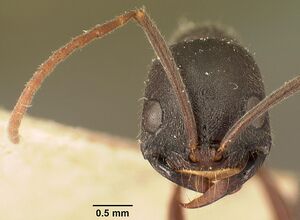   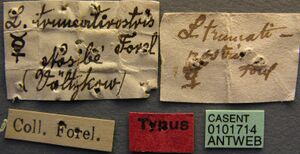
| |
| Paralectotype of Leptogenys truncatirostris. Worker. Specimen code casent0101714. Photographer April Nobile, uploaded by California Academy of Sciences. | Owned by MHNG, Geneva, Switzerland. |
   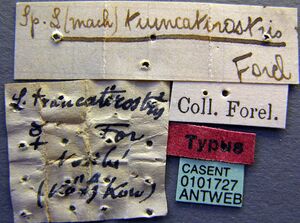
| |
| Paralectotype of Leptogenys truncatirostris. Worker. Specimen code casent0101727. Photographer April Nobile, uploaded by California Academy of Sciences. | Owned by MHNG, Geneva, Switzerland. |
  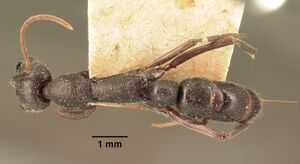 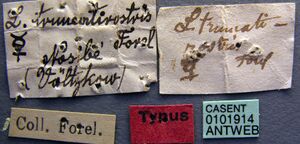
| |
| Paralectotype of Leptogenys truncatirostris. Worker. Specimen code casent0101914. Photographer April Nobile, uploaded by California Academy of Sciences. | Owned by MHNG, Geneva, Switzerland. |
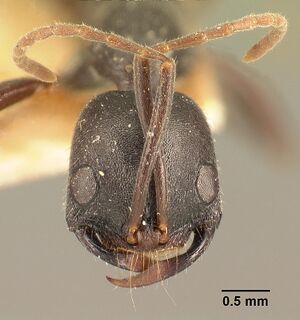  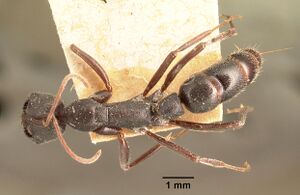 
| |
| Lectotype of Leptogenys truncatirostris. Worker. Specimen code casent0101940. Photographer April Nobile, uploaded by California Academy of Sciences. | Owned by MHNG, Geneva, Switzerland. |
   
| |
| Paralectotype of Leptogenys truncatirostris. Worker. Specimen code casent0101975. Photographer April Nobile, uploaded by California Academy of Sciences. | Owned by MHNG, Geneva, Switzerland. |
 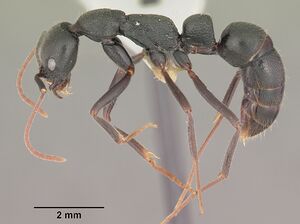 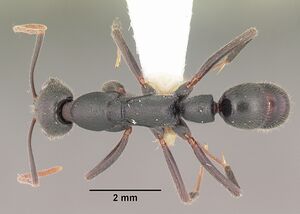 
| |
| Worker. Specimen code casent0102412. Photographer April Nobile, uploaded by California Academy of Sciences. | Owned by NHMUK, London, UK. |
Nomenclature
The following information is derived from Barry Bolton's Online Catalogue of the Ants of the World.
- truncatirostris. Leptogenys truncatirostris Forel, 1897c: 195, fig. 2 (w.) MADAGASCAR. Forel, 1907g: 76 (m.). Combination in L. (Machaerogenys): Emery, 1911d: 101. See also: Bolton, 1975a: 295.
Unless otherwise noted the text for the remainder of this section is reported from the publication that includes the original description.
Description
Worker
Rakotonirina and Fisher (2014) - (15 specimens). HW: 1.55–1.79, HL: 1.67–1.89, CI: 93–101, SL: 1.65–1.94, SI: 103–110, PW: 1.00–1.16, WL: 2.67–3.10, PNH: 0.88–1.03, PNL: 0.75–0.94, PNW: 0.72–0.89, DNI: 84–106, LNI: 106–119.
Head broadest anterior to eyes; sides slightly diverging anteriorly throughout its length; posterior margin weakly concave. Eye large, size between one-third and one-fourth the length of side of head; not breaking outline of lateral cephalic margin in full-face view. Mandible elongate; in profile, mandible strongly bent downward; in full-face view, blade widest near distal half, then progressively decreasing in breadth through apical tooth; preapical tooth may be present. Clypeus widely transverse anteriorly, junction of lateral section with anterior margin visibly angulate; anterior margin bordered by wide and thick yellowish membrane; median carina absent. Antennal scape fairly short, extending beyond posterior border of head by roughly one-fourth its length. With mesosoma in dorsal view, metanotal groove with transverse stration; in profile, propodeal lobe a blunt angle or absent. Dorsum of head reticulate-punctulate to reticulate rugulose. Apical half of mandible densely and finely striate and with reddish-orange surface. In dorsal view, mesosoma and petiolar node densely and finely reticulate-rugulose, interspersed with small punctures; propodeal declivity transversely striate. In profile, third abdominal tergite variably sculptured, either densely punctulate or microreticulate with scattered punctulae. Standing hairs and abundant pubescence present on mesosoma, petiolar node, and gaster. Body color black to dark brown; appendages brown at the base and becoming lighter toward the apex. Variation. Leptogenys truncatirostris shows considerable geographic variation. Two different forms have been recorded together in the RS Bemarivo. The form that most closely matches the holotype has the mandible with a slender median portion. The other form possesses mandibles that are much more robust and have a broadened median portion. Specimens collected from another site, RP Berenty, have a more rounded anterior clypeal margin.
Type Material
Rakotonirina and Fisher (2014) - Lectotype worker, Madagascar, Nosy-be (Voeltzkow) present designation, AntWeb specimen code: CASENT0101940 (Musee d'Histoire Naturelle Genève) [examined]. Paralectotypes: series of 6 workers same data but specimen coded as: CASENT0101914, CASENT0101714, CASENT0101975, CASENT0101727, CASENT0101626 (MHNG) [examined].
References
- Bolton, B. 1975a. A revision of the ant genus Leptogenys Roger (Hymenoptera: Formicidae) in the Ethiopian region with a review of the Malagasy species. Bull. Br. Mus. (Nat. Hist.) Entomol. 31: 235-305 (page 295, see also)
- Emery, C. 1911e. Hymenoptera. Fam. Formicidae. Subfam. Ponerinae. Genera Insectorum 118: 1-125 (page 101, Combination in L. (Machaerogenys))
- Forel, A. 1897d. Ameisen aus Nossi-Bé, Majunga, Juan de Nova (Madagaskar), den Aldabra-Inseln und Sansibar, gesammelt von Herrn Dr. A. Voeltzkow aus Berlin. Mit einem Anhang über die von Herrn Privatdocenten Dr. A. Brauer in Marburg auf den Seychellen und von Herrn. Abh. Senckenb. Naturforsch. Ges. 21: 185-208 (page 195, fig. 2 worker described)
- Forel, A. 1907i. Ameisen von Madagaskar, den Comoren und Ostafrika. Wiss. Ergeb. Reise Ostafr. 2: 75-92 (page 76, male described)
- Rakotonirina, J.C. & Fisher, B.L. 2014. Revision of the Malagasy ponerine ants of the genus Leptogenys Roger (Hymenoptera: Formicidae). Zootaxa 3836, 1-163.
- Subedi, I.P., Budha, P.B., Bharti, H., Alonso, L., Yamane, S. 2023. Ponerine ants of Nepal (Hymenoptera: Formicidae, Ponerinae): a generic synopsis, new faunal records, and rediscovery of a rare ant, Emeryopone franzi (Baroni Urbani 1975). (doi:10.20362/am.016003).
References based on Global Ant Biodiversity Informatics
- Bolton B. 1975. A revision of the ant genus Leptogenys Roger (Hymenoptera: Formicidae) in the Ethiopian region with a review of the Malagasy species. Bulletin of the British Museum (Natural History). Entomology 31: 235-305.
- Emery C. 1911. Hymenoptera. Fam. Formicidae. Subfam. Ponerinae. Genera Insectorum 118: 1-125.
- Fisher B. L. 1997. Biogeography and ecology of the ant fauna of Madagascar (Hymenoptera: Formicidae). Journal of Natural History 31: 269-302.
- Fisher B. L. 2003. Formicidae, ants. Pp. 811-819 in: Goodman, S. M.; Benstead, J. P. (eds.) 2003. The natural history of Madagascar. Chicago: University of Chicago Press, xxi + 1709 pp.
- Forel A. 1897. Ameisen aus Nossi-Bé, Majunga, Juan de Nova (Madagaskar), den Aldabra-Inseln und Sansibar, gesammelt von Herrn Dr. A. Voeltzkow aus Berlin. Mit einem Anhang über die von Herrn Privatdocenten Dr. A. Brauer in Marburg auf den Seychellen und von Herrn Perrot auf Ste. Marie (Madagaskar) gesammelten Ameisen. Abhandlungen der Senckenbergischen Naturforschenden Gesellschaft 21: 185-208.
- Forel A. 1904. Note sur les fourmis du Musée Zoologique de l'Académie Impériale des Sciences à St. Pétersbourg. Ezheg. Zool. Muz. 8: 368-388.
- Forel A. 1907. Ameisen von Madagaskar, den Comoren und Ostafrika. Wissenschaftliche Ergebnisse. Reise in Ostafrika 2: 75-92.
- Rakotonirina J. C., and B. L. Fisher. 2014. Revision of the Malagasy ponerine ants of the genus Leptogenys Roger (Hymenoptera: Formicidae). Zootaxa 3836 (1): 001163.
- Wheeler W. M. 1922. Ants of the American Museum Congo expedition. A contribution to the myrmecology of Africa. IX. A synonymic list of the ants of the Malagasy region. Bulletin of the American Museum of Natural History 45: 1005-1055

